Ethical Challenges of Leadership: A Comprehensive Examination
VerifiedAdded on 2022/08/11
|6
|1510
|21
Homework Assignment
AI Summary
This assignment explores various ethical challenges in leadership, addressing questions on followership, Machiavellianism, socialization, and courage. It examines moral exclusion, the veil of ignorance, and the components of moral action. The assignment also covers principled negotiation and the key concepts of servant leadership, as well as the positive effects of authentic leadership. The answers are based on the provided chapters from the textbook, and the assignment aims to provide a comprehensive overview of ethical dilemmas and leadership approaches.
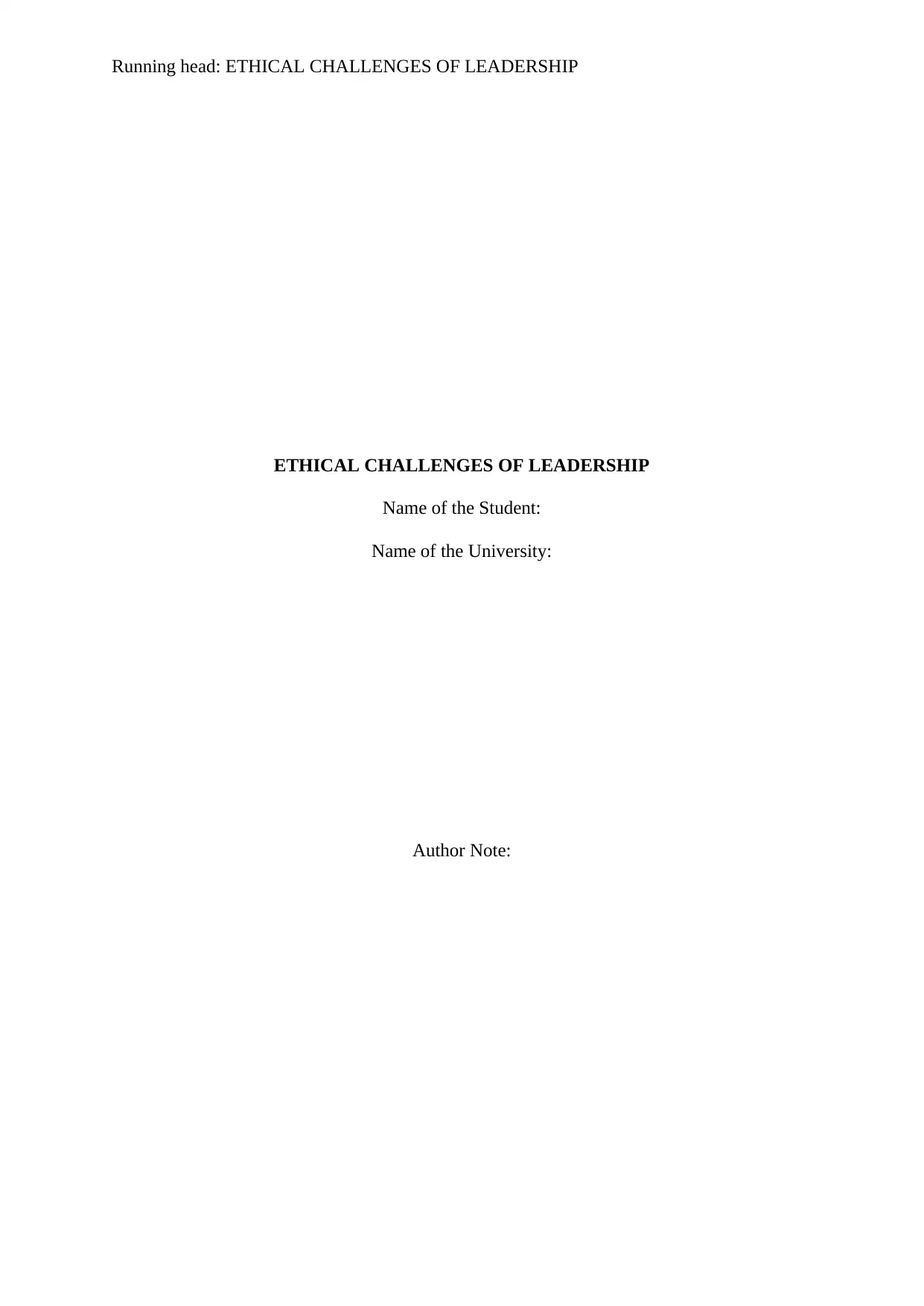
Running head: ETHICAL CHALLENGES OF LEADERSHIP
ETHICAL CHALLENGES OF LEADERSHIP
Name of the Student:
Name of the University:
Author Note:
ETHICAL CHALLENGES OF LEADERSHIP
Name of the Student:
Name of the University:
Author Note:
Paraphrase This Document
Need a fresh take? Get an instant paraphrase of this document with our AI Paraphraser
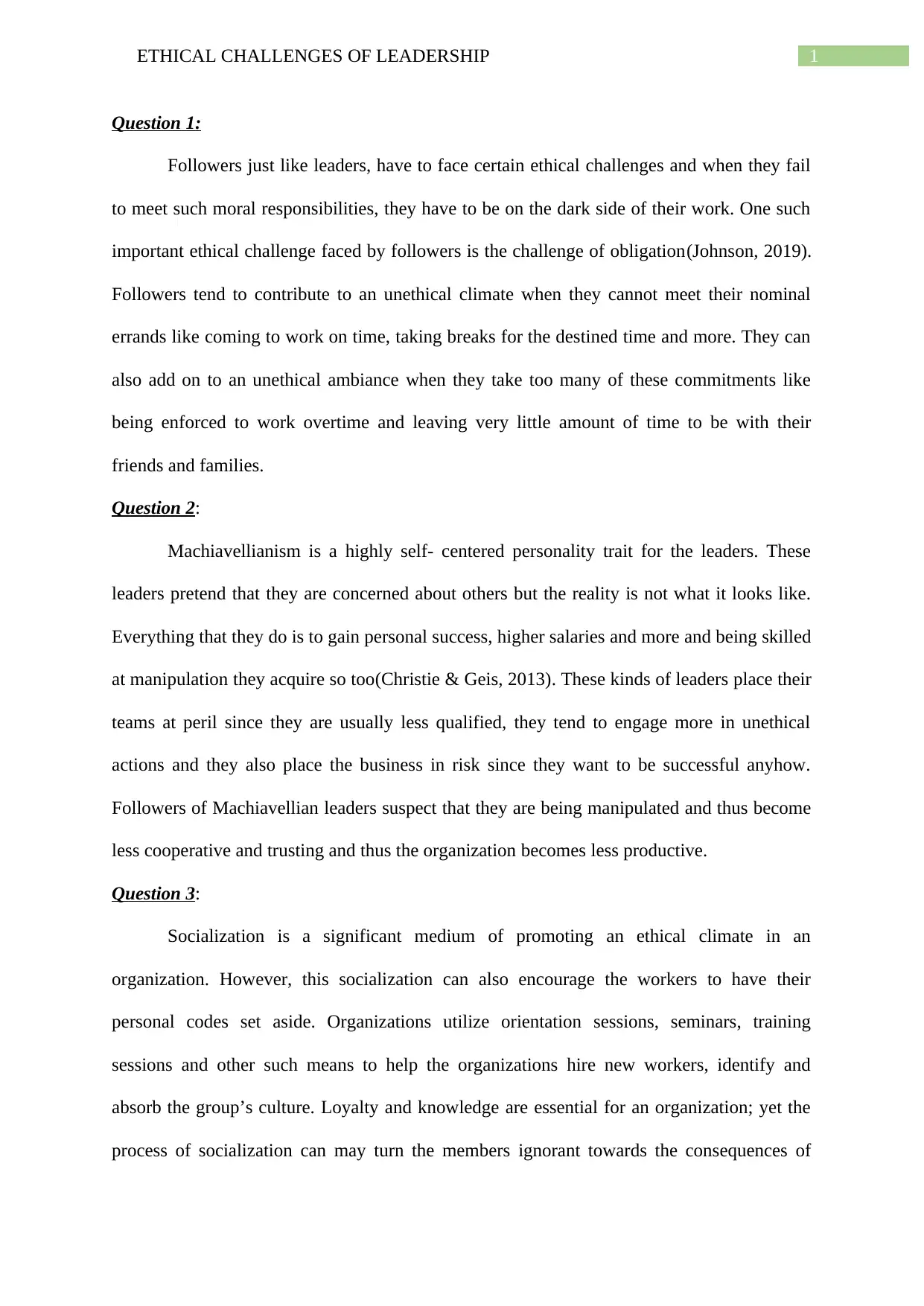
1ETHICAL CHALLENGES OF LEADERSHIP
Question 1:
Followers just like leaders, have to face certain ethical challenges and when they fail
to meet such moral responsibilities, they have to be on the dark side of their work. One such
important ethical challenge faced by followers is the challenge of obligation(Johnson, 2019).
Followers tend to contribute to an unethical climate when they cannot meet their nominal
errands like coming to work on time, taking breaks for the destined time and more. They can
also add on to an unethical ambiance when they take too many of these commitments like
being enforced to work overtime and leaving very little amount of time to be with their
friends and families.
Question 2:
Machiavellianism is a highly self- centered personality trait for the leaders. These
leaders pretend that they are concerned about others but the reality is not what it looks like.
Everything that they do is to gain personal success, higher salaries and more and being skilled
at manipulation they acquire so too(Christie & Geis, 2013). These kinds of leaders place their
teams at peril since they are usually less qualified, they tend to engage more in unethical
actions and they also place the business in risk since they want to be successful anyhow.
Followers of Machiavellian leaders suspect that they are being manipulated and thus become
less cooperative and trusting and thus the organization becomes less productive.
Question 3:
Socialization is a significant medium of promoting an ethical climate in an
organization. However, this socialization can also encourage the workers to have their
personal codes set aside. Organizations utilize orientation sessions, seminars, training
sessions and other such means to help the organizations hire new workers, identify and
absorb the group’s culture. Loyalty and knowledge are essential for an organization; yet the
process of socialization can may turn the members ignorant towards the consequences of
Question 1:
Followers just like leaders, have to face certain ethical challenges and when they fail
to meet such moral responsibilities, they have to be on the dark side of their work. One such
important ethical challenge faced by followers is the challenge of obligation(Johnson, 2019).
Followers tend to contribute to an unethical climate when they cannot meet their nominal
errands like coming to work on time, taking breaks for the destined time and more. They can
also add on to an unethical ambiance when they take too many of these commitments like
being enforced to work overtime and leaving very little amount of time to be with their
friends and families.
Question 2:
Machiavellianism is a highly self- centered personality trait for the leaders. These
leaders pretend that they are concerned about others but the reality is not what it looks like.
Everything that they do is to gain personal success, higher salaries and more and being skilled
at manipulation they acquire so too(Christie & Geis, 2013). These kinds of leaders place their
teams at peril since they are usually less qualified, they tend to engage more in unethical
actions and they also place the business in risk since they want to be successful anyhow.
Followers of Machiavellian leaders suspect that they are being manipulated and thus become
less cooperative and trusting and thus the organization becomes less productive.
Question 3:
Socialization is a significant medium of promoting an ethical climate in an
organization. However, this socialization can also encourage the workers to have their
personal codes set aside. Organizations utilize orientation sessions, seminars, training
sessions and other such means to help the organizations hire new workers, identify and
absorb the group’s culture. Loyalty and knowledge are essential for an organization; yet the
process of socialization can may turn the members ignorant towards the consequences of
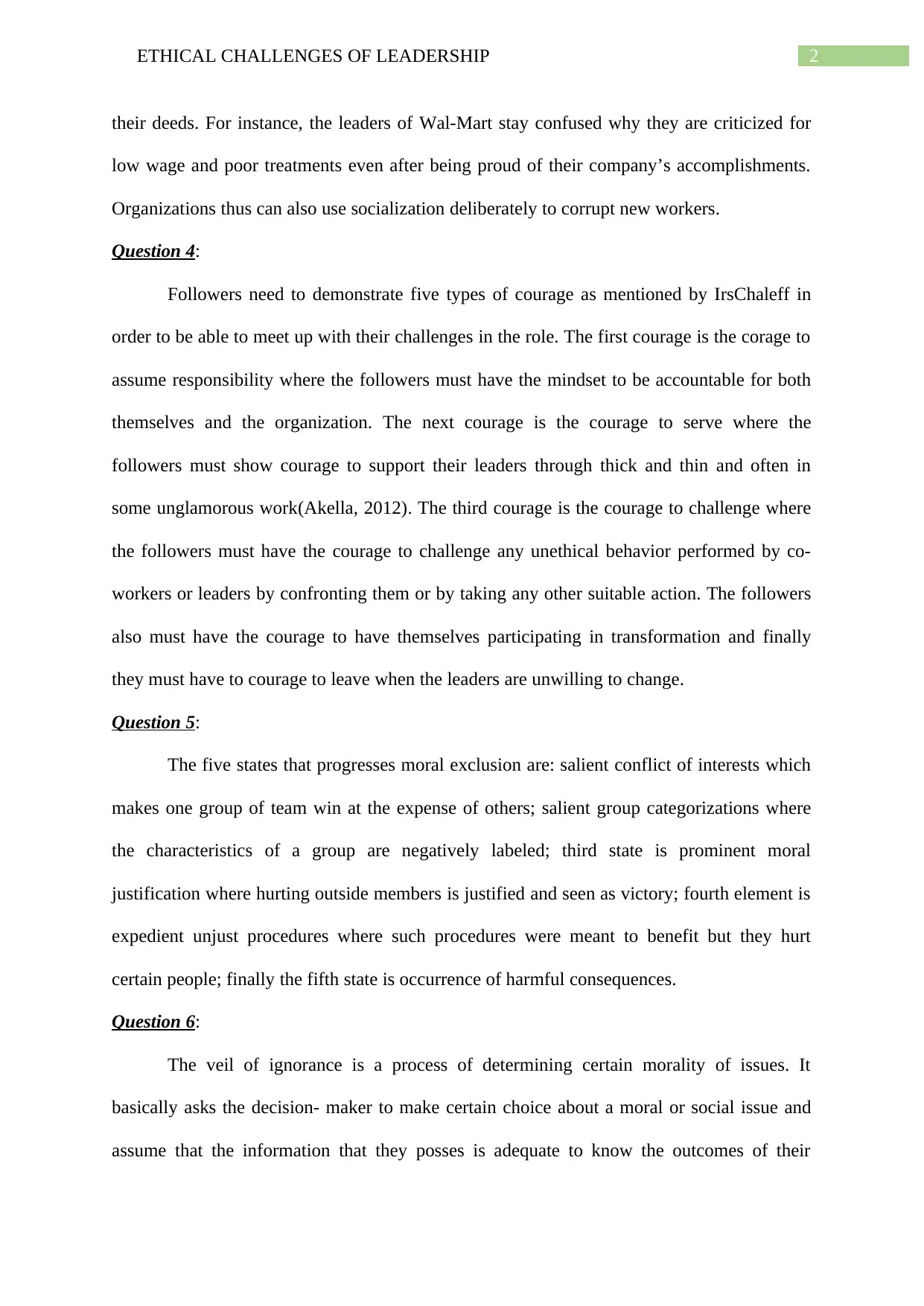
2ETHICAL CHALLENGES OF LEADERSHIP
their deeds. For instance, the leaders of Wal-Mart stay confused why they are criticized for
low wage and poor treatments even after being proud of their company’s accomplishments.
Organizations thus can also use socialization deliberately to corrupt new workers.
Question 4:
Followers need to demonstrate five types of courage as mentioned by IrsChaleff in
order to be able to meet up with their challenges in the role. The first courage is the corage to
assume responsibility where the followers must have the mindset to be accountable for both
themselves and the organization. The next courage is the courage to serve where the
followers must show courage to support their leaders through thick and thin and often in
some unglamorous work(Akella, 2012). The third courage is the courage to challenge where
the followers must have the courage to challenge any unethical behavior performed by co-
workers or leaders by confronting them or by taking any other suitable action. The followers
also must have the courage to have themselves participating in transformation and finally
they must have to courage to leave when the leaders are unwilling to change.
Question 5:
The five states that progresses moral exclusion are: salient conflict of interests which
makes one group of team win at the expense of others; salient group categorizations where
the characteristics of a group are negatively labeled; third state is prominent moral
justification where hurting outside members is justified and seen as victory; fourth element is
expedient unjust procedures where such procedures were meant to benefit but they hurt
certain people; finally the fifth state is occurrence of harmful consequences.
Question 6:
The veil of ignorance is a process of determining certain morality of issues. It
basically asks the decision- maker to make certain choice about a moral or social issue and
assume that the information that they posses is adequate to know the outcomes of their
their deeds. For instance, the leaders of Wal-Mart stay confused why they are criticized for
low wage and poor treatments even after being proud of their company’s accomplishments.
Organizations thus can also use socialization deliberately to corrupt new workers.
Question 4:
Followers need to demonstrate five types of courage as mentioned by IrsChaleff in
order to be able to meet up with their challenges in the role. The first courage is the corage to
assume responsibility where the followers must have the mindset to be accountable for both
themselves and the organization. The next courage is the courage to serve where the
followers must show courage to support their leaders through thick and thin and often in
some unglamorous work(Akella, 2012). The third courage is the courage to challenge where
the followers must have the courage to challenge any unethical behavior performed by co-
workers or leaders by confronting them or by taking any other suitable action. The followers
also must have the courage to have themselves participating in transformation and finally
they must have to courage to leave when the leaders are unwilling to change.
Question 5:
The five states that progresses moral exclusion are: salient conflict of interests which
makes one group of team win at the expense of others; salient group categorizations where
the characteristics of a group are negatively labeled; third state is prominent moral
justification where hurting outside members is justified and seen as victory; fourth element is
expedient unjust procedures where such procedures were meant to benefit but they hurt
certain people; finally the fifth state is occurrence of harmful consequences.
Question 6:
The veil of ignorance is a process of determining certain morality of issues. It
basically asks the decision- maker to make certain choice about a moral or social issue and
assume that the information that they posses is adequate to know the outcomes of their
⊘ This is a preview!⊘
Do you want full access?
Subscribe today to unlock all pages.

Trusted by 1+ million students worldwide
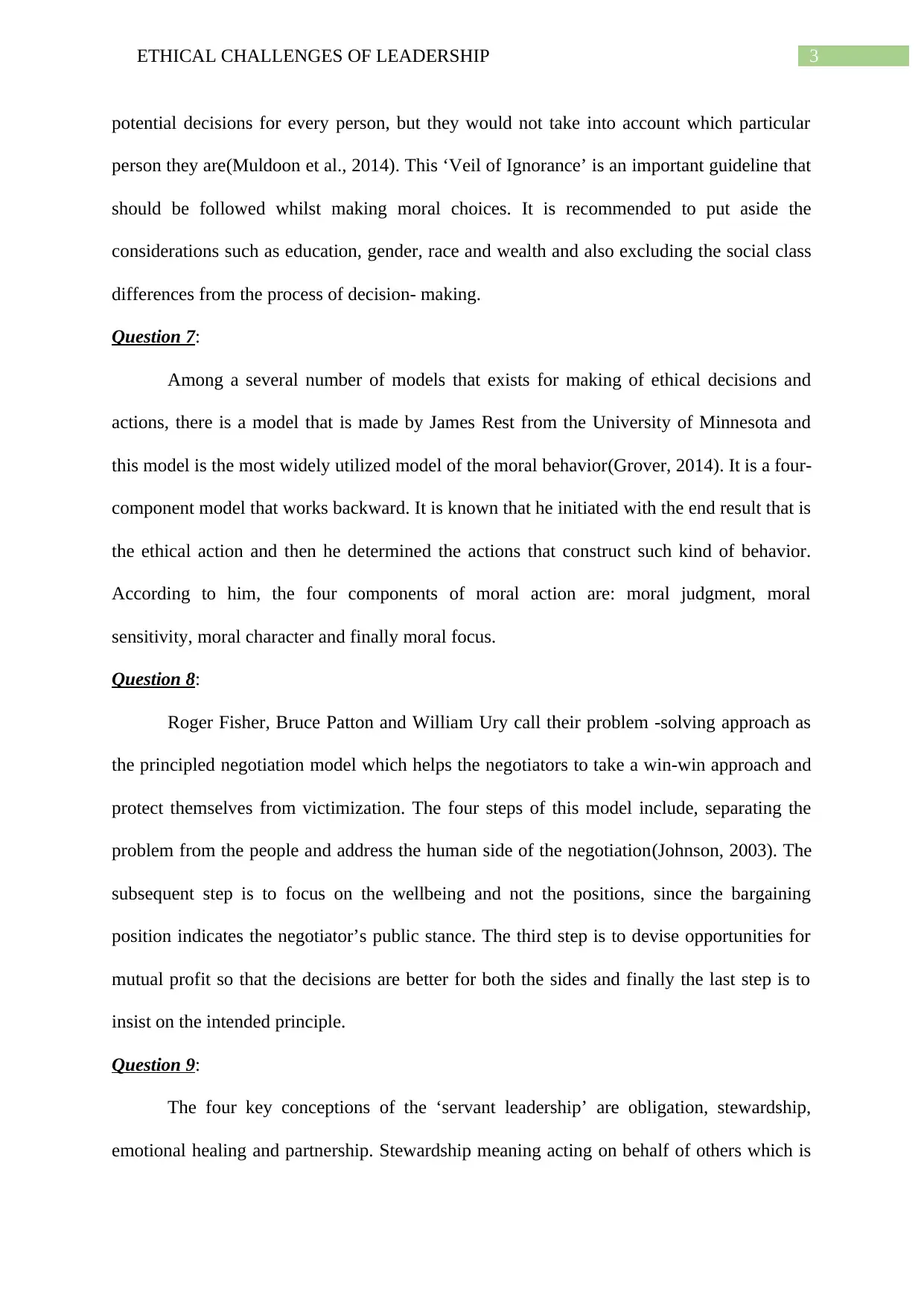
3ETHICAL CHALLENGES OF LEADERSHIP
potential decisions for every person, but they would not take into account which particular
person they are(Muldoon et al., 2014). This ‘Veil of Ignorance’ is an important guideline that
should be followed whilst making moral choices. It is recommended to put aside the
considerations such as education, gender, race and wealth and also excluding the social class
differences from the process of decision- making.
Question 7:
Among a several number of models that exists for making of ethical decisions and
actions, there is a model that is made by James Rest from the University of Minnesota and
this model is the most widely utilized model of the moral behavior(Grover, 2014). It is a four-
component model that works backward. It is known that he initiated with the end result that is
the ethical action and then he determined the actions that construct such kind of behavior.
According to him, the four components of moral action are: moral judgment, moral
sensitivity, moral character and finally moral focus.
Question 8:
Roger Fisher, Bruce Patton and William Ury call their problem -solving approach as
the principled negotiation model which helps the negotiators to take a win-win approach and
protect themselves from victimization. The four steps of this model include, separating the
problem from the people and address the human side of the negotiation(Johnson, 2003). The
subsequent step is to focus on the wellbeing and not the positions, since the bargaining
position indicates the negotiator’s public stance. The third step is to devise opportunities for
mutual profit so that the decisions are better for both the sides and finally the last step is to
insist on the intended principle.
Question 9:
The four key conceptions of the ‘servant leadership’ are obligation, stewardship,
emotional healing and partnership. Stewardship meaning acting on behalf of others which is
potential decisions for every person, but they would not take into account which particular
person they are(Muldoon et al., 2014). This ‘Veil of Ignorance’ is an important guideline that
should be followed whilst making moral choices. It is recommended to put aside the
considerations such as education, gender, race and wealth and also excluding the social class
differences from the process of decision- making.
Question 7:
Among a several number of models that exists for making of ethical decisions and
actions, there is a model that is made by James Rest from the University of Minnesota and
this model is the most widely utilized model of the moral behavior(Grover, 2014). It is a four-
component model that works backward. It is known that he initiated with the end result that is
the ethical action and then he determined the actions that construct such kind of behavior.
According to him, the four components of moral action are: moral judgment, moral
sensitivity, moral character and finally moral focus.
Question 8:
Roger Fisher, Bruce Patton and William Ury call their problem -solving approach as
the principled negotiation model which helps the negotiators to take a win-win approach and
protect themselves from victimization. The four steps of this model include, separating the
problem from the people and address the human side of the negotiation(Johnson, 2003). The
subsequent step is to focus on the wellbeing and not the positions, since the bargaining
position indicates the negotiator’s public stance. The third step is to devise opportunities for
mutual profit so that the decisions are better for both the sides and finally the last step is to
insist on the intended principle.
Question 9:
The four key conceptions of the ‘servant leadership’ are obligation, stewardship,
emotional healing and partnership. Stewardship meaning acting on behalf of others which is
Paraphrase This Document
Need a fresh take? Get an instant paraphrase of this document with our AI Paraphraser
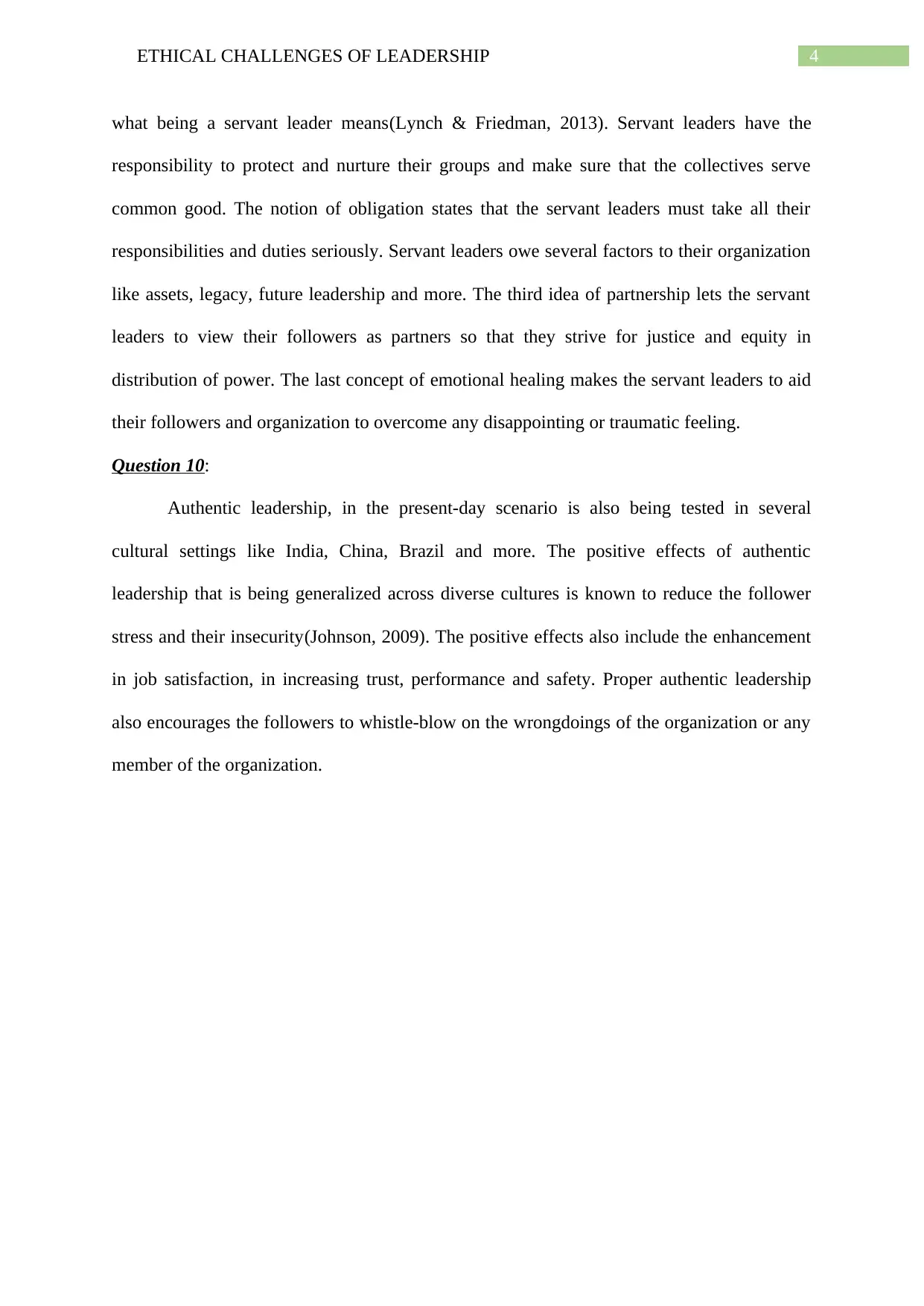
4ETHICAL CHALLENGES OF LEADERSHIP
what being a servant leader means(Lynch & Friedman, 2013). Servant leaders have the
responsibility to protect and nurture their groups and make sure that the collectives serve
common good. The notion of obligation states that the servant leaders must take all their
responsibilities and duties seriously. Servant leaders owe several factors to their organization
like assets, legacy, future leadership and more. The third idea of partnership lets the servant
leaders to view their followers as partners so that they strive for justice and equity in
distribution of power. The last concept of emotional healing makes the servant leaders to aid
their followers and organization to overcome any disappointing or traumatic feeling.
Question 10:
Authentic leadership, in the present-day scenario is also being tested in several
cultural settings like India, China, Brazil and more. The positive effects of authentic
leadership that is being generalized across diverse cultures is known to reduce the follower
stress and their insecurity(Johnson, 2009). The positive effects also include the enhancement
in job satisfaction, in increasing trust, performance and safety. Proper authentic leadership
also encourages the followers to whistle-blow on the wrongdoings of the organization or any
member of the organization.
what being a servant leader means(Lynch & Friedman, 2013). Servant leaders have the
responsibility to protect and nurture their groups and make sure that the collectives serve
common good. The notion of obligation states that the servant leaders must take all their
responsibilities and duties seriously. Servant leaders owe several factors to their organization
like assets, legacy, future leadership and more. The third idea of partnership lets the servant
leaders to view their followers as partners so that they strive for justice and equity in
distribution of power. The last concept of emotional healing makes the servant leaders to aid
their followers and organization to overcome any disappointing or traumatic feeling.
Question 10:
Authentic leadership, in the present-day scenario is also being tested in several
cultural settings like India, China, Brazil and more. The positive effects of authentic
leadership that is being generalized across diverse cultures is known to reduce the follower
stress and their insecurity(Johnson, 2009). The positive effects also include the enhancement
in job satisfaction, in increasing trust, performance and safety. Proper authentic leadership
also encourages the followers to whistle-blow on the wrongdoings of the organization or any
member of the organization.
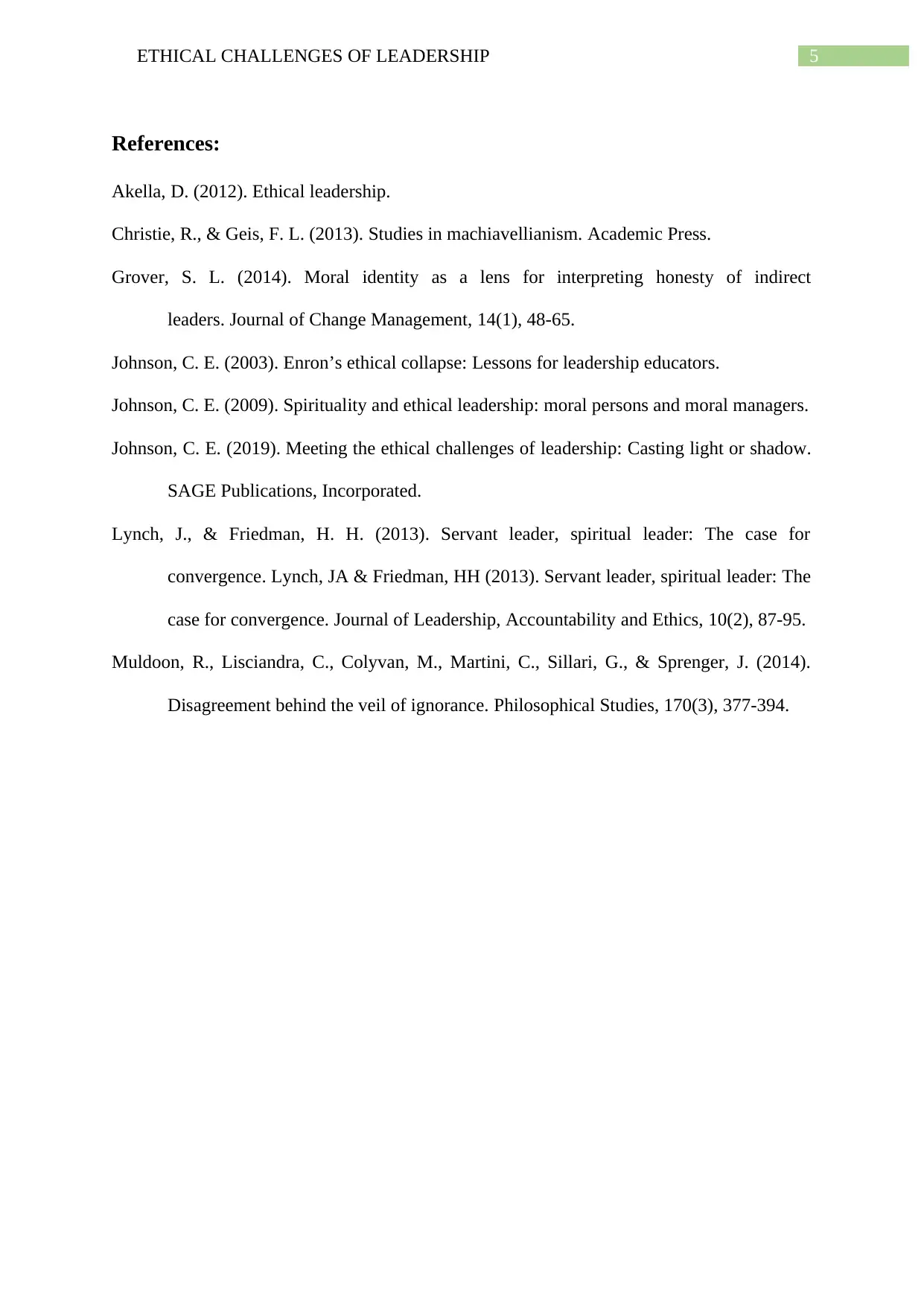
5ETHICAL CHALLENGES OF LEADERSHIP
References:
Akella, D. (2012). Ethical leadership.
Christie, R., & Geis, F. L. (2013). Studies in machiavellianism. Academic Press.
Grover, S. L. (2014). Moral identity as a lens for interpreting honesty of indirect
leaders. Journal of Change Management, 14(1), 48-65.
Johnson, C. E. (2003). Enron’s ethical collapse: Lessons for leadership educators.
Johnson, C. E. (2009). Spirituality and ethical leadership: moral persons and moral managers.
Johnson, C. E. (2019). Meeting the ethical challenges of leadership: Casting light or shadow.
SAGE Publications, Incorporated.
Lynch, J., & Friedman, H. H. (2013). Servant leader, spiritual leader: The case for
convergence. Lynch, JA & Friedman, HH (2013). Servant leader, spiritual leader: The
case for convergence. Journal of Leadership, Accountability and Ethics, 10(2), 87-95.
Muldoon, R., Lisciandra, C., Colyvan, M., Martini, C., Sillari, G., & Sprenger, J. (2014).
Disagreement behind the veil of ignorance. Philosophical Studies, 170(3), 377-394.
References:
Akella, D. (2012). Ethical leadership.
Christie, R., & Geis, F. L. (2013). Studies in machiavellianism. Academic Press.
Grover, S. L. (2014). Moral identity as a lens for interpreting honesty of indirect
leaders. Journal of Change Management, 14(1), 48-65.
Johnson, C. E. (2003). Enron’s ethical collapse: Lessons for leadership educators.
Johnson, C. E. (2009). Spirituality and ethical leadership: moral persons and moral managers.
Johnson, C. E. (2019). Meeting the ethical challenges of leadership: Casting light or shadow.
SAGE Publications, Incorporated.
Lynch, J., & Friedman, H. H. (2013). Servant leader, spiritual leader: The case for
convergence. Lynch, JA & Friedman, HH (2013). Servant leader, spiritual leader: The
case for convergence. Journal of Leadership, Accountability and Ethics, 10(2), 87-95.
Muldoon, R., Lisciandra, C., Colyvan, M., Martini, C., Sillari, G., & Sprenger, J. (2014).
Disagreement behind the veil of ignorance. Philosophical Studies, 170(3), 377-394.
⊘ This is a preview!⊘
Do you want full access?
Subscribe today to unlock all pages.

Trusted by 1+ million students worldwide
1 out of 6
Related Documents
Your All-in-One AI-Powered Toolkit for Academic Success.
+13062052269
info@desklib.com
Available 24*7 on WhatsApp / Email
![[object Object]](/_next/static/media/star-bottom.7253800d.svg)
Unlock your academic potential
Copyright © 2020–2025 A2Z Services. All Rights Reserved. Developed and managed by ZUCOL.





